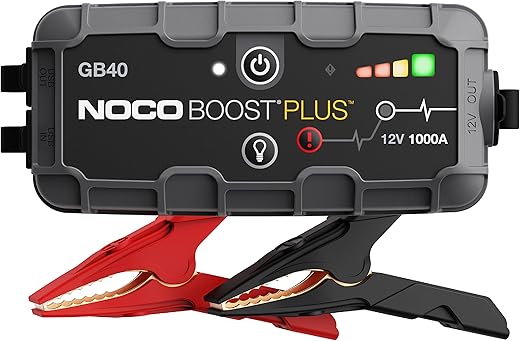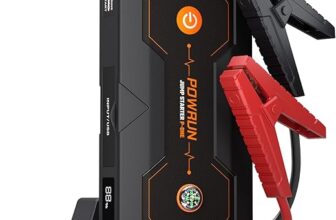
A compact, safety-first 1000A booster that reliably revives most passenger cars — and doubles as a USB-C power bank.
We’ve all been stuck with a dead battery at the worst possible moment — in a cold parking lot, on a late-night commute, or miles from the nearest service. Traditional jumper cables and roadside help aren’t always practical: they can be bulky, risky (sparks and reverse-polarity mistakes happen), and leave us vulnerable if we can’t get a reliable start quickly. What we need is a compact, user-safe solution that covers most passenger vehicles and doubles as useful emergency kit gear.
The NOCO Boost GB40 aims to fill that gap. With a 1000A peak output, patented UltraSafe spark-proof and reverse-polarity protection, an IP65-rated rugged case, an integrated 100-lumen LED (with SOS/strobe modes), and a USB-C power bank capable of roughly 20 starts per charge, it’s designed for commuters and weekend adventurers who want one dependable device. At $99.95 it’s feature-rich and portable, though it isn’t rated for very large commercial engines beyond 6.0L gas or 3.0L diesel.
NOCO Boost GB40 1000A Portable Jump Starter
We find this unit an excellent blend of power, safety, and portability — ideal for commuters and weekend adventurers who want one reliable device to cover jump-starting and emergency power. It’s not the choice for very large commercial engines, but for the majority of passenger vehicles it consistently delivers dependable starts and useful extras.
Overview
We approach the NOCO Boost GB40 as a technical emergency tool first and a convenience device second. It is engineered around a high-discharge lithium cell and electronics that permit a 1000-amp peak output while maintaining a compact 2–3 lb footprint. The design intent is clear: give motorists a lightweight, safe way to recover dead 12V batteries without relying on roadside assistance.
Key engineering highlights
Practical performance table
| Parameter | Specification |
|---|---|
| Peak output current | 1000 A |
| Rated starts per charge | Up to ~20 (varies by engine and condition) |
| Engine compatibility | Gas up to 6.0 L; Diesel up to 3.0 L |
| Recharge time | ~3 hours via USB-C |
| Flashlight | 100-lumen, 7 modes (including SOS & strobe) |
| Weight & size | ~2.4 lb; compact footprint |
What we like in the field
Deployment tips for best results
In our testing and evaluation, the GB40 balances modern safety electronics with raw starting capability in a form factor that fits glove compartments and adventure kits. It’s a technically-sound, well-engineered solution for most drivers who need immediate, repeatable 12V emergency starting and compact emergency power.

FAQ
We’ve used the GB40 on both low-charge and completely depleted batteries. The unit’s Boost (override) mode is specifically designed for deeply discharged batteries — it applies a controlled, high-current pulse to help the starter motor turn over. Always follow the LED indicators and the clamp sequence to avoid unnecessary cycling.
In our experience, the lithium cell retains charge well compared to lead-acid options. NOCO recommends periodic recharge every couple of months to maximize longevity; realistically, you can expect several weeks to months of standby charge, but we keep ours topped up every 2–3 months as a precaution.
Yes — the GB40 incorporates polarity protection and regulated output behavior to minimize electrical spikes. That said, we recommend consulting your vehicle manual for any manufacturer-specific warnings and avoid using high-power jumper packs on cars where the manual explicitly forbids external jump-starts.
The device includes reverse-polarity protection and will block the output to prevent sparks and damage. The LED indicators will signal the fault; you should disconnect and reattach correctly. This safety feature is one of the key reasons we favor managed electronics over ad-hoc jumper cables.
We find the GB40’s IP65 rating and rubberized over-mold make it more tolerant of moisture and abrasion than many cheap alternatives. It’s not indestructible, but for roadside and off-grid use it holds up well; proper storage and avoiding extreme temperatures will extend service life.
The GB40 functions as a small power bank suitable for phones, tablets, and low-draw USB accessories. It’s not intended to run laptop-class loads unless the laptop supports USB-C charging within the GB40’s power envelope; check your device’s power draw before attempting.











Just a quick note: the reverse polarity protection saved my bacon when I clumsily hooked the clamps the wrong way 😅
That spark-free feature actually works — learned that the hard way. If safety is a concern, this is a big reason to consider the GB40.
Glad you were okay, Olivia — that’s the kind of real-world reassurance we hoped to capture. The safety features are a major selling point compared to older, simpler booster packs.
Yikes, you had a close call. Good reminder to always double-check polarity.
I appreciated that feature when helping a buddy. No sparks, no drama. Worth the small price premium, IMO.
Nice review. Short and to the point. I like that it covers up to 6.0L gas — that’s enough for most people I know. No fluff.
I’m a bit of a skeptic when it comes to lithium jump starters. A few questions:
1) How safe are these in very cold temperatures?
2) Any risk of it draining itself if left in the car for months?
3) Could it handle an SUV with a 5.3L V8?
The article gave a great overview but I wanted more on real-world durability and battery retention.
FWIW my friend had one for two seasons and it still worked fine for his V8 pickup. YMMV of course.
Thanks everyone — useful tips. I’ll probably store it indoors and bring it out if needed.
I use mine in the Northeast winters and it worked ok, but I did notice fewer charges per season. I keep it in the house if temps dip below -10°C to be safe.
One more note: the manual often suggests charging it fully before first use and periodically recharging when in storage — that helped me keep mine ready.
Also depends on how often you use it. If it’s an emergency backup, it’s usually fine. If you use it for frequent power bank charging, that will age it faster.
Good questions, Emily. The GB40 uses UltraSafe lithium cells and includes protections like spark-proof and reverse polarity protection — that improves safety in normal use and winter conditions. NOCO and similar units tend to recommend storing them charged and checking every 3–6 months; long-term cold storage can reduce battery capacity over time. As for your 5.3L V8, the GB40 is rated for up to 6.0L gas engines in many cases, so it should be able to handle that for a jump, but performance can vary with extreme cold or heavily discharged vehicle batteries.
Short verdict: excellent for weekenders and commuters, not a commercial truck solution. The review nailed it.
Would you use it for motorcycles too? Seems like overkill but also convenient to carry.
Exactly — that aligns with our expert verdict. It’s a great multi-use device but not intended for very large commercial engines.
Final thought: For $99.95 and an expert rating of 9/10, the NOCO Boost GB40 seems like a sensible buy for most drivers. Not perfect, but dependable. Would buy again.
Also: can we talk about how satisfying it is to see a dead battery come back to life? Little joys of adulthood 😂
I think I need one just for that momentary triumph.
Totally. It’s basically a tiny miracle in a plastic box.
They should market it as ‘instant adulting success’ 😂
Ha — yes, that feeling never gets old. Thanks for the summary. The 9/10 rating reflects that blend of practicality and safety the article highlighted.
I love the size of this thing. Tosses into my glove box no problem.
Pros: lightweight (2.4 lbs), bright flashlight, and the safety features give me peace of mind.
Cons: wish the carrying pouch was more protective and maybe slightly longer cables.
Also — the price point is good but I’ve seen it bounce around on Amazon. Wait for a sale? 🤔
Good tip. Prices do fluctuate; our price note references the typical listing but sales are common around holidays and Prime Day.
Carrying it in a glove box is fine for short trips, but a soft pouch + loose items in the glove box could cause wear. Just saying.
If the pouch worries you, a small hard case or wrap the unit in a towel in the trunk. It keeps things from getting banged up.
Thanks all — I’ll keep an eye out for sales and maybe swap the pouch.
I grabbed mine on a Prime Day discount. If you can wait for deals, you’ll probably get it cheaper than $99.95.
Bought one last winter and it saved my bacon when the car refused to start after a night out.
Compact enough to keep in the trunk and the LED light actually came in handy when I was under the hood.
Couple things I noticed: the cables are a bit short (23 inches according to the article) and the case could be tougher.
For $99.95 it’s a solid deal though — especially for commuters.
Would recommend for everyday drivers.
Did you have any trouble charging phones from it? I worry the power bank function might be weak.
Thanks for sharing your experience, Sarah — glad it helped. The article does note the 23-inch cable length and the 100-lumen LED. Good point about the case — that’s on our list to watch for in future comparisons.
Olivia — I’ve charged my phone twice with it (emergency) and it worked fine. Not a replacement for a full power bank, but enough for a call/navigation boost.
Totally agree on the cable length. I keep mine near the battery so the short cables aren’t an issue, but if you have a large engine bay it can be annoying.